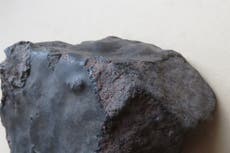Scientists discover 3,000-year-old arrowhead made of ‘alien’ iron
Ancient Estonian meteorite was likely source for metal in arrowhead, scientists say
A 3,000-year-old arrowhead housed in Switzerland’s Bern History Museum was made using iron from a meteorite, scientists have said.
Researchers describe the features of the arrowhead and the likely source of the iron-rich meteorite in a new study published in the Journal of Archaeological Science.
Previous research has found that iron from meteorites was widely used by ancient human societies, with many such examples of early meteoric iron use discovered in Europe.
In the new study, researchers assessed archaeological collections across Switzerland to verify if any of these artifacts were made of metal from meteorites.
They found that the arrowhead at the Bern History Museum was made partly of a form of aluminium not naturally found on Earth.
In this arrowhead, researchers also found an iron and nickel alloy that has only been detected in meteorites.
This arrowhead was discovered at a Bronze Age site called Mörigen, where early people are known to have lived between 900 and 800 BCE.
Researchers initially speculated that the arrowhead was made using metal from the Twannberg meteorite that crashed less than 8km from the site where the weapon part was found.
However, they found that the concentrations of germanium and nickel did not match between the meteorite sample and the arrowhead.
Looking for another likely source in a geological database of meteorites, scientists found only three other meteorites previously discovered in Europe had the same combination of metals as seen in the arrowhead.
One was in the Czech Republic, the other in Spain and the third in Estonia.
Researchers now believe the Estonian meteorite would have been the most likely source for the arrowhead.
The findings suggest there may have been an extensive trade network between early locations in Estonia and Switzerland during the Bronze Age in Central Europe.
“Among just three large European iron meteorites with fitting chemical composition, the Kaalijarv meteorite (Estonia) is the most likely source,” scientists wrote in the study.
They noted that the meteorite’s large crater-forming event in Estonia likely happened at around 1500BC during the Bronze Age and produced many small fragments.
“The discovery and subsequent transport/trade of such small iron fragments appear much more likely than in case of buried large meteorite masses,” researchers wrote, adding that additional artifacts of the same origin may be present in other archaeological collections.
Join our commenting forum
Join thought-provoking conversations, follow other Independent readers and see their replies
Comments


Bookmark popover
Removed from bookmarks